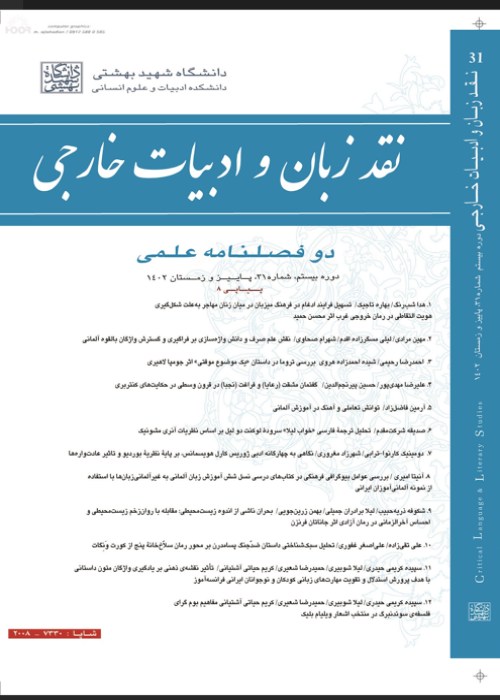Quest for places and self: A Study of Flowers of Ruin by Patrick Modiano based on Geopoetic Theory
Geopoetics is a new theory in art and literature critic that studies the importance of places in literary and artistic creations. Geopoetics is an open and interdisciplinary approach. It is a link between literature and geography. Also, it is related to the philosophy and intellectual nomadism. Although this approach is new, it shows the knowledge of its founders on the science of East and West. Geopoetics aims at placing the link between man and Earth at the center of reflection. It is a geo-centered approach - geo in Greek means earth - which gives a primordial place to literature. It consists of two terms: the geo prefix and the poetic suffix. The “geo”, that is, the earth and our place in the cosmos. In this article, we will first study what geopoetics means and then we will check how geopoetics relates to the Other. And for that, we will analyze Fleurs de Ruine by Patrick Modiano. The works of Patrick Modiano are good examples. It has the same precision as that of a cartographer. He is the novelist of the Parisian space. The wandering of its narrator, of its characters, allows the evocation of places. We can say that he does not live in Paris but he circulates there. Walking and wandering is the central theme in Ruined Flowers. We see from the beginning of the novel the places traveled by the narrator-walker. We can see using Google Maps the landscape seen by the narrator and we can be on the place where this character was.
Michel Chaillou who, in his book Le Sentiment Géographique (1976), checks the geographic space and who declares that in this kind of text, “reading is not walking , at first sight “but the reality is that during reading” the sentence becomes a path. So we can say that Modiano’s sentences are paths to travel that highlight mobility. What is essential for a geopoetic reading. Geopoetic reading is also a journey, a displacement especially through thought. The reader-critic tries to follow the steps of the narrator and the character. He thinks simultaneously of his relationship with the land and places. He also wonders what relationship he could establish with this place described by the author. The critic is thus present in his analyzes and he has an active role in the geopoetic approach.
During this study, the meeting with the other is inevitable. The city is the meeting place with the other, as Barthes says, and wandering prepares for the sometimes unexpected meetings with the other. The narrator is a walker. While walking, he meets the other characters who are often pedestrians too when they walk in the streets or when they frequent other places like coffee, bar, cinema, etc. This is how spatiality is strongly linked to the question of otherness. For the narrator-walker, the Other and the sometimes hazardous encounter with him remind us of the places frequented and the places can also, in turn, evoke the memory of Others. The landscapes and spaces remind him of other people. For us, it’s quite significant that a place reminds him of a character, an Other. This shows that geopoetic study is inseparable from the study of the Other. The main question is to understand what the role of places in the novel is and how places can help humans to know themselves.
to answer our initial question: how does geopoetics help us read the text? It must be said that during a geopoetic reading, the reader inhabits the text. He follows the steps of the writer. He travels the world as tirelessly as he does and gives space a central place. What we did in reading Flowers of Ruin by Modiano. Thus, reading becomes a path. In this round trip between the world of the text and his world, by a mental movement, he inevitably meets otherness, especially cultural otherness. It’s the unchanging constancy of geopoetics to listen to the Other while crossing places. The Other is not defined only in human relationships but in the meeting of a culture and a crossed space. We have already mentioned that in the geopoetic approach, openness to the world and meeting with the Other is very important. We see that Modiano’s narrator meets the Other during his walks. This meeting with the Other is very decisive in his quest for identity.
- حق عضویت دریافتی صرف حمایت از نشریات عضو و نگهداری، تکمیل و توسعه مگیران میشود.
- پرداخت حق اشتراک و دانلود مقالات اجازه بازنشر آن در سایر رسانههای چاپی و دیجیتال را به کاربر نمیدهد.


